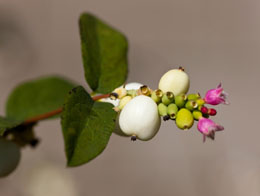The snow-white berries, twiggy branches, and green foliage of the snowberry shrub make it an ideal choice for landscaping. This write-up provides information on the ideal conditions required for its growth.

Snowberry shrub is a deciduous shrub that belongs to
Caprifoliaceae or the
Honeysuckle family. Many species of this shrub are categorized under
Symphoricarpos genus.
Symphoricarpos albus, also known as common snowberry, is one of the most common varieties of this shrub. It is native to parts of North America. Due to its beautiful foliage, flowers, and snow-white berries, this shrub is grown in residential or commercial spaces. Many landscaping artists use it to add visual interest. To add to that, even hummingbirds are attracted to this shrub. So, if you have this shrub in your garden, you will surely get to see hummingbirds flitting around its twiggy branches and the snow-white flowers.
Characteristics
➞ Birds are attracted to this shrub, which makes it a great choice for the gardening enthusiasts and those who enjoy watching birds.
➞ It has a dense growth and an excellent root system, which is why this shrub is also planted for the purpose of soil preservation.
➞ It has a dark green oval-shaped foliage. The leaves are about 2-4 centimeters in size. The leaves are arranged as opposite pairs along the stem.
➞ The flowers are snowy-white with a tinge of pink. The bloom season starts from June and persists through the month of September.
➞ The berries that
Symphoricarpos albus produces are also referred to as ice apples. The berries make an appearance during the fall and persist through the winter season.
➞ Though all birds might not enjoy eating these berries, birds such as pheasant, quail and grouse enjoy eating these ice apples.
➞ There are other varieties of this deciduous shrub that produce pink berries. These are referred to as coralberry.
➞ The
Symphoricarpos albus variety can grow up to a height of five to six feet.
➞ While the berries look very attractive, these contain a substance called saponin. Ingesting raw berries could cause dermatitis, dizziness and vomiting. So, if you have small children in your home, make sure that these berries are not within the reach of your children.
Caring for This Shrub
➞ Not only is this a fast growing shrub, it is quite hardy as well. While it grows well in full sun, it will also survive in partial shade.
➞ As far as the soil requirements are concerned, make sure that the soil is well-drained.
➞ Ideally, the soil pH must be in the range of 6.8 to 7.7.
➞ This shrub can grow well in loamy or sandy soil.
➞ While planting the root ball in the soil, make sure that you don't plant it too deep. The width of the planting hole should be double the width of the root ball.
➞ Though you must water it regularly during the first growth season, refrain from over-watering.
➞ Mulching is also important. Adding a thick layer of mulch will help control the growth of weeds, but make sure that the mulch doesn't cover the trunk of this shrub.
➞ This shrub is also grown for the purposes of landscaping. It can be used in shrub borders, hedges or as a ground cover, but for it to look attractive, one must pay attention to pruning. Since this bush has dense and twiggy branches, make sure that you prune the interiors properly.
The snowberry shrub is hardy plant, so it will grow well even with a little care. While this shrub will produce beautiful flowers and berries, you will also have the pleasure of seeing beautiful birds hovering around this bush.






 Snowberry shrub is a deciduous shrub that belongs to Caprifoliaceae or the Honeysuckle family. Many species of this shrub are categorized under Symphoricarpos genus. Symphoricarpos albus, also known as common snowberry, is one of the most common varieties of this shrub. It is native to parts of North America. Due to its beautiful foliage, flowers, and snow-white berries, this shrub is grown in residential or commercial spaces. Many landscaping artists use it to add visual interest. To add to that, even hummingbirds are attracted to this shrub. So, if you have this shrub in your garden, you will surely get to see hummingbirds flitting around its twiggy branches and the snow-white flowers.
Snowberry shrub is a deciduous shrub that belongs to Caprifoliaceae or the Honeysuckle family. Many species of this shrub are categorized under Symphoricarpos genus. Symphoricarpos albus, also known as common snowberry, is one of the most common varieties of this shrub. It is native to parts of North America. Due to its beautiful foliage, flowers, and snow-white berries, this shrub is grown in residential or commercial spaces. Many landscaping artists use it to add visual interest. To add to that, even hummingbirds are attracted to this shrub. So, if you have this shrub in your garden, you will surely get to see hummingbirds flitting around its twiggy branches and the snow-white flowers.